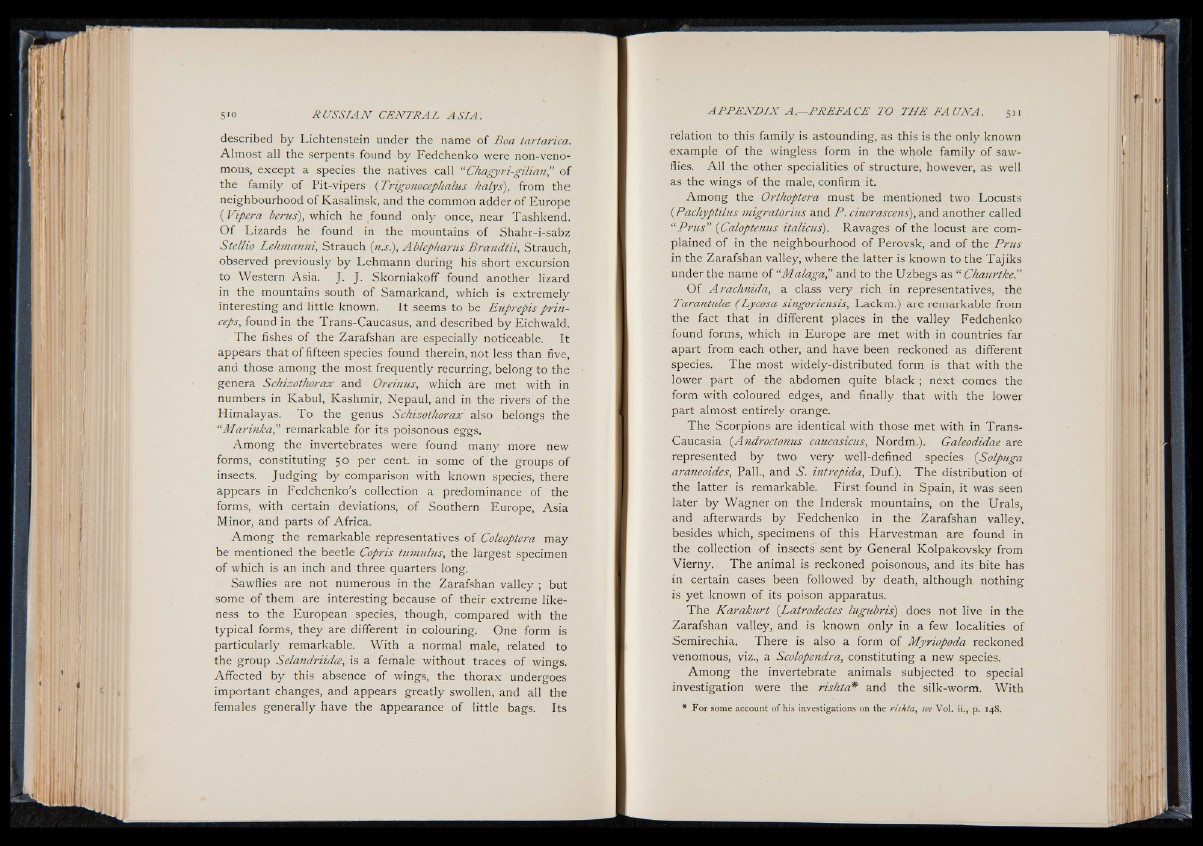
described by Lichtenstein under the name of Boa tartarica.
Almost all the serpents found by Fedchenko were non-veno-
mous, except a species the natives call “ Ckagyri-gilian,” of
the family of Pit-vipers (Trigonocephalus halys), from the
neighbourhood of Kasalinsk, and the common adder of Europe
( Vipera herns'), which he found only once, near Tashkend.
O f Lizards he found in the mountains of Shahr-i-sabz
Stellio Lehmanni, Strauch (n.s.), Ablepharus Brandtii, Strauch,
observed previously by Lehmann during his short excursion
to Western Asia. J. J. Skorniakoff found another lizard
in the mountains south of Samarkand, which is extremely
interesting and little known. It seems to be Eüprepis princeps,
found in the Trans-Caucasus, and described by Eichwald.
The fishes of the Zarafshan are especially noticeable. It
appears that of fifteen species found therein, not less than five,
and those among the most frequently recurring, belong to the
genera Schizothorax and Oreinus, which are met with in
numbers in Kabul, Kashmir, Nepaul, and in the rivers of the
Himalayas. To the genus Schizothorax also belongs the
“MarinkaP remarkable for its poisonous eggs.
Among the invertebrates were found many more new
forms, constituting 50 per cent, in some of the groups of
insects. Judging by comparison with known species, there
appears in Fedchenko’s collection a predominance of the
forms, with certain deviations, of Southern Europe, Asia
Minor, and parts of Africa.
Among the remarkable representatives of Coleóptera may
be mentioned the beetle Copris tumulus, the largest specimen
of which is an inch and three quarters long.
Sawflies are not numerous in the Zarafshan valley ; but
some of them are interesting because of their extreme likeness
to the European species, though, compared with the
typical forms, they are different in colouring. One form is
particularly remarkable. With a normal male, related to
the group Selandriidce, is a female without traces of wings.
Affected by this absence of wings, the thorax undergoes
important changes, and appears greatly swollen, and all the
females generally have the appearance of little bags. Its
relation to this family is astounding, as this is the only known
example o f the wingless form in the whole family of saw-
flies. All the other specialities of structure, however, as well
as the wings of the male, confirm it.
Among the Orthoptera must be mentioned two Locusts
(.Pachyptilus migratorius and P . cinerascens'), and another called
“ P ru s” (Caloptenus italicus). Ravages of the locust are complained
of in the neighbourhood of Perovsk, and of the Prus
in the Zarafshan valley, where the latter is known to the Tajiks
under the name of “Malaga," and to the Uzbegs as “ Chaurtke!'
O f Arachnida, a class very rich in representatives, the
Tarantulce (Lycosa singoriensis, Lackm.) are remarkable from
the fact that in different places in the valley Fedchenko
found forms, which in Europe are met with in countries far
apart from each other, and have been reckoned as different
species. The most widely-distributed form is that with the
lower part of the abdomen quite black ; next comes the
form with coloured edges, and finally that with the lower
part almost entirely orange.
The Scorpions are identical with those met with in Trans-
Caucasia (Androctonus caucasicus, Nordm.). Galeodidae are
represented by two very well-defined species (Solpuga
araneoides, Pall., and S', intrepida, Duf.). The distribution of
the latter is remarkable. First found in Spain, it was seen
later by Wagner on the Indersk mountains, on the Urals,
and afterwards by Fedchenko in the Zarafshan valley,
besides which, specimens of this Harvestman are found in
the collection of insects sent by General Kolpakovsky from
Vierny. The animal is reckoned poisonous, and its bite has
in certain cases been followed by death, although nothing
is yet known of its poison apparatus.
The Karakurt (Latrodectes lugubris) does not live in the
Zarafshan valley, and is known only in a few localities of
Semirechia. There is also a form of Myriopoda reckoned
venomous, viz., a Scolopendra, constituting a new species.
Among the invertebrate animals subjected to special
investigation were the rishta* and the silk-worm. With